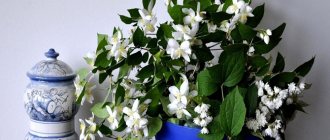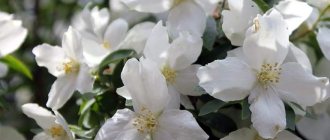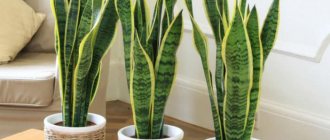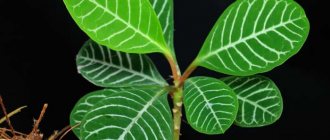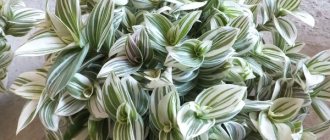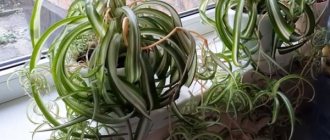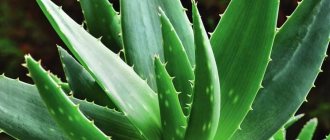Jasmine is a shrubby plant from the Olive family. In the wild, it is distributed in the tropics and subtropics in both hemispheres. It is impossible to find real jasmine in the middle zone and further north. It is grown from seeds in greenhouses, greenhouses and houses.
In garden conditions, a plant with a similar aroma is planted - mock orange. But the shrubs belong to different families, the flowers are easy to distinguish from each other.
Jasminum
Mock orange (Philadelphus)
The photo shows that jasmine has pistils and stamens hidden in an elongated tube. In mock orange, after the bud opens, they are clearly visible.
There are 198 species of shrubs. The following are common:
- Sambac, Arabian or Indian jasmine. A climbing plant native to Pakistan, India, and the eastern Himalayas. The buds are white with a strong aroma.
- Italian yellow. Shade-tolerant species. The flowers are yellow.
- Shrub jasmine. Found in the Caucasus, Crimea, southern Western Europe, Syria, Israel, Georgia, Iran, Lebanon. It has yellow inflorescences and can withstand frosts down to -25 degrees.
- Holofloral jasmine. Originally from China, it has simple buds and is grown as an ornamental plant.
- White or medicinal. It has fragrant flowers and is used for the production of essential oil.
- Multi-flowered. Distributed in China. It has white fragrant buds.
- Madagascar. Grown as a houseplant.
Sambac, Arabian or Indian jasmine (Jasminum sambac)
Italian yellow jasmine (Jasminum humile)
Bush jasmine (Jasminum fruticans)
Jasmine (Jasminum nudiflorum)
Officinalis or white jasmine (Jasminum officinale)
Multifloral jasmine (Jasminum polyanthum)
Madagascar jasmine (Stephanotis floribunda)
Jasmine flowers are very popular in Asia and are called the “kings of fragrances.” In Pakistan, Indonesia and the Philippines they believe in their magical powers and are considered national symbols. In these countries, the shrub is called “Chambeli”, “Melati”, “Sampaguita”.
The healing properties of the plant were discovered in ancient China. All its parts were used for treatment, but the most popular remedy was jasmine tea made from flowers. Today he is known in all countries of the world. Below we will talk about the beneficial properties of the plant, possible harm, rules for preparing and drinking a drink from flowers.
Useful, medicinal properties
In folk medicine, multi-flowered and medicinal types of jasmine are used. The fruits of the bush are inedible, but the roots are used in the preparation of medicinal infusions with an analgesic effect. The leaves serve as raw materials for the creation of wound healing agents.
This is how jasmine is grown in China
Industrial collection of jasmine in China
Jasmine processing in Fujian Province (China)
This is how jasmine flowers are sold in India.
The flowers of the plant are widely used. They are used to make healing and tonic fragrant teas, cosmetics and aromatic liquids. What are the health benefits of jasmine:
- Improves mood and gives vigor.
- Prevents the development of oncology.
- Strengthens the immune system.
- Prevents the formation of cholesterol plaques and blood clots.
- Accelerates the production of digestive enzymes and the breakdown of fats.
- Normalizes blood circulation.
- Activates brain activity.
- Removes excess fluid from the body.
- Increases reproductive function.
- Improves intestinal function, stimulates peristalsis.
- Prevents the accumulation of toxins.
- Strengthens blood vessels and maintains their elasticity.
Features of benefits for women and men
Useful properties of jasmine for women:
- Relief during menopause. Drinks with flowers help cope with mood swings, maintain clarity of consciousness, and get rid of hot flashes.
- Relieving menstrual pain, eliminating pathologies of the reproductive system. The smell of jasmine tea reduces spasms, and the substances it contains relieve inflammation during genitourinary infections.
- Reducing the risk of developing breast cancer. Jasmine contains antioxidants that prevent the formation of malignant cells.
For men:
- Preventing the development of prostatitis. The drink promotes blood flow to the genitourinary organs, reduces the intensity of inflammation, and accelerates the elimination of diseases that provoke pathology.
- Normalization of reproductive functions, improvement of potency. Herbal remedies are used as a natural aphrodisiac.
- Increased performance. The drink tones up and improves the speed of thinking.
May improve brain function
Jasmine tea has several properties that can help improve brain function.
For starters, it contains 15-60 mg of caffeine per cup (237 ml) - depending on how long the tea is steeped and what type of tea is used as the base.
Caffeine stimulates your nervous system by blocking the inhibitory neurotransmitter adenosine, a chemical that carries signals between your brain and body. Typically, adenosine helps your body relax (16).
In addition, caffeine increases brain activity and promotes the release of other mood-enhancing neurotransmitters, such as dopamine and serotonin (17).
Together, it makes you feel more alert and energized, and improves short-term memory (18).
Jasmine tea also contains the amino acid L-theanine, which triggers the release of gamma-aminobutyric acid (GABA), an inhibitory neurotransmitter that puts you in a relaxed and alert state.
When taken together, L-theanine and caffeine appear to be more effective at improving brain function (19, 20).
Summary:
Jasmine tea contains caffeine and L-theanine, which can help you be more alert and alert. In addition, its use can improve short-term memory.
Contraindications and possible harm
Jasmine tea can bring not only benefits, but also harm to health.
Contraindications to the use of products from the flowers of the bush:
- Allergy to the main component or individual intolerance to substances contained in its composition.
- Pathologies associated with cardiac arrhythmia. Jasmine can cause increased heart rate and increased blood pressure.
It is beneficial to drink 2-3 cups of jasmine tea per day. You should avoid taking the drink at night: it provokes insomnia.
Abuse of jasmine affects the body as follows:
- Causes exacerbation of gastrointestinal diseases.
- Increases blood glucose levels.
- Disturbs the water-salt balance.
Botanical description
The genus jasmine (lat. Jasminum) , which has up to 300 species, belongs to the Olive family. They grow mainly in the subtropical and tropical zones of Australia, Africa and Asia; One species of this plant grows in South America and the Mediterranean. The jasmine plant comes in both vines and shrubs, and there are both evergreen plants and species that shed their foliage. The leaves grow either opposite each other in a circle or alternately; they are either trifoliate or odd-pinnate in shape. Flowers grow both at the top and on the sides; They gather in shields, or grow one at a time, or cluster in umbrellas. The corolla can be pink (but quite rarely), yellow and white, and saucer-shaped in shape; The corolla tube is cylindrical, the throat is open. To prevent jasmine from being confused with mock orange, which belongs to the saxifrage family, it is also called “true jasmine.” The only thing that connects them is the smell. Jasmine will grow well in a winter garden or room. This plant is beautifully flowering, usually hanging. Thin shoots at the top of the plant need support over time, because... the lower part becomes woody.
Pregnant and lactating
Green tea with jasmine can be both beneficial and harmful to a pregnant woman.
Pros of the drink:
- eliminates swelling;
- normalizes emotional state;
- strengthens the immune system;
- improves digestion.
Cons of tea:
- increases blood pressure;
- provokes insomnia;
- can cause an allergic reaction;
- creates a load on the kidneys.
Before use, you should consult your doctor. If there are no contraindications, you can drink weak tea with flowers 1–2 cups per day.
During breastfeeding, you should avoid drinking this drink. Active compounds penetrate into milk and enter the child’s body. Jasmine contains substances that can cause allergies, nervousness and insomnia in a baby.
4. Promotes good oral health
Jasmine tea is usually based on green tea, which contains catechins. Catechins are a group of polyphenols that may help protect against tooth decay or caries by killing plaque-forming bacteria such as Streptococcus mutans (4, 13).
In a study of 15 people, a solution containing green tea catechins stopped Streptococcus mutans from producing acid when applied to teeth. Too much acid can erode tooth enamel, the hard surface of teeth (4).
Another study of 30 people found that using a green tea catechin mouthwash for 1 week was as effective in reducing plaque as an antiseptic mouthwash (14).
Not to mention, some research suggests that jasmine tea may combat bad breath by reducing odor-causing bacteria (15).
Summary:
The polyphenols in jasmine tea may help neutralize plaque-forming bacteria such as Streptococcus mutans. They can also combat bad breath.
Is it possible for children
Jasmine tea should not be given to children under 3 years of age. In children, the drink provokes excitability and sleep disturbance. From 4–6 years old, 1 cup per day in the morning is allowed. Tea helps:
- reduce the risk of colds;
- activate brain function;
- accelerate the decrease in temperature during acute respiratory infections, influenza;
- prevent digestive disorders.
Children of primary and senior school age can drink 2 cups per day if they are not allergic to the plant.
Acceptable daily allowance
Tea is a rather concentrated and rich drink, excessive consumption of which can cause a number of not very pleasant side effects and lead to negative consequences. This is why it is so important to follow the dosage recommended by doctors.
So, experts advise drinking no more than two liters of aromatic liquid per day. Of course, this volume is spread over several doses, for example, in the morning, at lunch, in the evening and several hours before bedtime. This amount is quite enough to quench your thirst, recharge your energy, and increase your own performance.
You should be especially careful with drinking in the afternoon. Since it contains caffeine, you can easily trigger insomnia by simply ignoring the recommended daily intake.
Recommendations from nutritionists for losing weight
When losing weight, drinks with jasmine are recommended to be consumed instead of black tea or coffee. Benefit:
- accelerates fat burning processes;
- prevents decreased immunity;
- normalizes digestive functions;
- eliminates the development of nervous disorders;
- relieves the body of toxins.
To speed up the process of losing pounds, flowers are added to green tea. The drink should be prepared without sugar or other sweeteners.
When to collect and how to dry
Jasmine begins to bloom 2 years after planting. The peculiarity of the bush is that the buds bloom at night, so you need to collect the raw materials before sunrise.
Procurement rules:
- We cut flowers in dry weather, at 4–5 am. We select half-opened or blossoming buds without signs of spoilage. We place the raw materials in a wide container so that the flowers are not damaged by tamping.
- We dry the buds under a canopy on the street or at home in a ventilated area for 4–5 days. During preparation, periodically carefully turn it over so that moisture does not accumulate below and provoke rotting processes.
You cannot speed up the process using an oven or electric dryer: you can burn the delicate petals. Store the finished raw materials in a closed tin or glass jar or canvas bags away from direct sunlight and moisture.
For face
Surprisingly, tea and jasmine products have found application even in home cosmetology. Due to their pronounced antibacterial and anti-inflammatory properties, they effectively fight acne and acne, and remove spot rashes.
What exactly is this tea good for the skin:
- helps eliminate aesthetic defects and imperfections;
- Providing an antioxidant effect, it fights premature aging and promotes cell renewal;
- accelerates regeneration processes, promoting faster healing of minor injuries.
Quite often, the flowers of the bush are involved in the preparation of special decoctions, which are then used to steam the face. They allow you to simultaneously disinfect and soften the skin, preparing it for subsequent manipulations.
In addition, such infusions are used to create masks. Just mix oatmeal and some oatmeal tea, apply it to your skin for ten minutes, and you will be pleasantly surprised. Redness will disappear, pores will tighten, and blackheads will become less pronounced. The main thing is not to forget to use a moisturizer at the end.
How to choose jasmine tea
In stores you can buy loose leaf and bagged tea with jasmine flowers. Pure raw materials are rarely sold. When choosing a product, it is better to give preference to luxury goods in loose form or in cardboard packages. The disadvantage of tea bags is the inability to evaluate the quality. The product may smell like jasmine, but contain fragrance instead of petals.
Selection rules:
- Study the composition of the raw materials in the box. It should not contain dyes or flavor enhancers.
- Consider the appearance of weighed raw materials. A high-quality product is crumbly, does not contain small particles, jasmine petals or buds are visible.
- Prefer goods made in China (Fujian province).
The best varieties of green tea with jasmine
Among the best Chinese varieties of jasmine tea are the following:
- Moly Yin Hao (“Silver Fibers”). It is made from young shoots of tea bushes, which are scented with flower petals during joint drying in a hermetically sealed room.
- Moli Zhen Zhu (“Jasmine Pearls”). Prepared from top tea leaves and jasmine. It has a tart taste and strong aroma.
- Chun Hao Wang (“Royal Jasmine”). Produced from a bud with a top leaf (flesh). The raw materials are dried with flowers, then the dried petals are taken out and fresh ones are added, and so on several times. The mixture produces an olive-colored infusion with a sweetish taste and strong aroma.
- Moly Zhen Luo (“Jasmine Snail”). For production, half-bloomed leaves are used, which curl when dry. Production takes place in 2 stages: in early spring, the raw materials of tea bushes are picked and prepared, and in summer flowers are added to the product.
- Moli Da Bai Hao (“Jasmine White Fluff”). Made in Fujian Province. The basis of the tea is large-leaf Bai Hao, which is aromatized three times with flower buds. The drink has a golden hue and a delicate taste.
- Moly Xue Gong Zhu (“Jasmine Snow Princess”). Made from large leaves, it retains its aroma after several brews.
- Chinese tea "Dragon Pearl". It is made from tea bushes that are adjacent to jasmine plantations and are filled with aroma during the growth process. During production, the raw materials are rolled into balls and scented with flowers. The buds are removed before packaging.
- Hou Wang (The Monkey King). Tea from Fujian province. Popular in China, it is distinguished by the presence of special codes on each package.
- Tian Zhen. Made from cut tea leaves during jasmine flowering.
Tea “Jasmine pearls”
Brewing tea while maintaining maximum benefits
Jasmine petals are thin and delicate; if brewed incorrectly, they lose their benefits, aroma and pleasant taste. The drink can be prepared in clay or porcelain containers, but the maximum amount of active compounds is preserved when using a thermos with a glass flask. A metal container is undesirable: useful elements will begin to collapse upon contact with the walls of the vessel.
Instructions for brewing jasmine tea:
- We heat the water to 70 degrees.
- Take a 500 ml thermos and pour boiling water over the inside.
- Pour 3 teaspoons of raw materials into a container.
- Fill with hot water.
- Close the thermos and leave for 30 minutes.
It is better to drink tea from porcelain or glass cups: iron containers help destroy active compounds, and earthenware absorbs the aroma of flowers. To prepare the drink, you need to use only purified water: impurities can spoil the delicate taste of jasmine.
Classic brewing methods, recipes
Classic recipes:
- With the addition of black, green, white tea. Take 4 teaspoons of leaves, 2 teaspoons of flowers, mix, pour into a porcelain teapot. Pour in 800 ml of water heated to 80 degrees. Leave for 10 minutes, strain.
- With mint, lofant, fireweed tea. Ingredients: lofant grass, jasmine, mint, fireweed tea 1 teaspoon each, 600 ml hot water. Pour the raw materials into a thermos, fill with liquid, leave for 30 minutes. Strain before use.
- With goji fruits. Preparation: mix several jasmine buds with 1 teaspoon of green tea and 2 goji berries. Pour the mixture into a kettle, pour 450 ml of water heated to 80 degrees. Let it sit for 5 minutes.
- With milk. We use our favorite type of green tea with jasmine. Fill the raw material with hot water (70–80 degrees), leave for 5 minutes. Strain and dilute with warmed milk in equal proportions.
Disease Prevention
Jasmine drink eliminates the risk of developing pathologies. Features of prevention with flower tea:
- Cancerous tumors. The buds contain substances with antioxidant properties. To reduce the likelihood of developing cancer, you need to drink 1 cup of herbal tea 2 times a day.
- Gastritis. During an exacerbation of the disease, it is not recommended to drink a drink with jasmine, but to eliminate repeated inflammation, you should take 2-3 cups a day.
- Pancreatitis. For prevention, choose the highest grades of green tea with jasmine. Brew the drink in a thermos for 15 minutes at the rate of 1 teaspoon of raw material per 400 ml of water, so that it turns out weak. Drink 2 cups per day in the morning. You cannot add milk, honey or berries to the drink.
- Diabetes. In case of illness, the maximum dose is 1 cup per day. It helps support digestion and strengthen the immune system. In large quantities, the drink is harmful, as it stimulates an increase in glucose levels in the body.
- Skin diseases. To eliminate pathologies, use alcohol tincture with jasmine. We prepare it like this: pour 150 g of flowers with 150 ml of alcohol, put the container with the liquid in a dark place for 7 days. We wash wounds and cuts with the prepared product. Apply lotions to the inflamed skin.
- Varicose veins The drink prevents the formation of blood clots and strengthens the walls of blood vessels and veins. For prevention, it can be consumed up to 5 times a day.
- Bronchial asthma. Jasmine helps reduce the risk of development and exacerbation of pathology, relieves symptoms. Classic tea with flowers helps with prevention. The disease is treated with a decoction of the buds, prepared in a water bath.
Effect on stomach cancer, study
In 2009, a group of specialists from the USA and China published the results of studies on the effect of jasmine tea on the formation and development of stomach cancer. Experts did not find convincing evidence that jasmine reduces the risk of cancer of the upper esophagus and gastric adenocarcinoma, but they did find a slowdown in the spread of malignant cells in squamous cell oncology of the esophagus.
Essential oil
Jasmine essential oil is an expensive product. To make 100 g you need 100 kg of fresh flowers. The product has pronounced antiseptic, anti-inflammatory, and analgesic properties. Due to its beneficial properties, jasmine essential oil has found wide use in cosmetology, gynecology and psychotherapy.
Examples of using:
- Preparation of body and hair care products. To enhance the aroma, jasmine is supplemented with neroli oil and magnolia extract.
- Perfumery production. When making products, the hydrolate left over from the evaporation of essential oil is used.
- Aromatherapy.
- Treatment of skin inflammations. Jasmine oil helps girls and boys get rid of teenage rashes on their faces.
- Preparing drinks with an analgesic effect.
The effect of the smell of jasmine on humans
The aroma of jasmine has a calming effect and increases libido. The effect of the scent depends on the method of application. Adding concentrated flower tea to your bath can help you relax. The herbal remedy is used during water birth: the woman endures contractions more easily and concentrates on the process. Aromatherapy sessions with flower oil increase libido in men and women.
Women's interest
People have used herbs to cure ailments since ancient times. In every village there were “herbalists” who healed the sick. The secrets of preparing tinctures and decoctions were passed down from one generation to another. Until now, our grandmothers use herbs instead of pharmaceutical drugs. This article will describe Jasmine officinalis. The aroma of this flower is unique and amazing. It is called the “King of Smells”, “Moonlight of Love”, “Scent of Bliss”.
Jasmine is a genus of shrubs from the olive family. Its homeland is considered to be Asia Minor and China. Jasmine is the national flower of Pakistan. It is used as decoration at wedding celebrations in Indonesia. In addition to its amazing smell and beautiful flower, jasmine has beneficial and healing properties.
Useful properties of jasmine
- Antiseptic. The growth and development of microorganisms is suppressed.
- Painkillers.
- Calming, mood-improving.
Indications for the use of jasmine
- Depression, stress.
- Insomnia.
— Wounds, dermatitis, eczema, other damage to the skin epithelium.
- Hormonal imbalance in the body. Disruption of the endocrine system.
- Headache.
- Bronchial asthma, bronchitis.
Jasmine, whose beneficial properties are remarkable, is usually used in the form of infusion, decoction, essential oil, and tea. The most common way to use it is green tea with this plant. It helps a person cope with emotional stress, improves mood, and increases performance. Its smell inspires new achievements and victories.
Jasmine green tea recipe
To prepare this drink you will need: 0.5 tbsp. jasmine and 1 tbsp. black or green tea. Mix the ingredients and brew with boiling water. Leave for 10 minutes. Add honey or lemon.
Compresses and lotions are used to treat wounds. For one glass of water you need 3 tsp. this flower.
For inflammatory processes on the face with oily or combination skin (acne, rashes, pustules), use a mask.
Face mask recipe
To prepare the mask you need 3 tbsp. jasmine flowers. They need to be ground to a paste. Then mix the resulting mixture with 100 g. butter. Apply to problem areas and remove after 10-15 minutes. Use externally.
Jasmine essential oil, which also has beneficial properties, has a beneficial effect on the body. It calms, improves mood, helps reduce headaches. In combination with other oils, it is used as an aphrodisiac.
People with asthma or bronchitis are prescribed inhalations with jasmine.
Jasmine - Contraindications
Each plant has contraindications and side effects for use. Jasmine, despite the beneficial properties of soy, has contraindications. Therefore, it is better to start using in small quantities. Carefully monitor your feelings and health conditions.
1. Jasmine essential oil in high concentrations or large doses (instead of 5 drops 15) leads to headaches and nosebleeds.
2. May cause allergic reactions.
3. Pregnancy and lactation period.
4.Children up to 6 years of age (if taken orally).
Jasmine in cosmetology
In cosmetics, jasmine is used to tone the skin, prevent inflammation and rejuvenate, and strengthen hair. Flowers give the products a pleasant subtle aroma.
Homemade cosmetics recipes:
- Acne mask. Ingredients: 2 drops of essential flower oil, 15 g of black bread crumb, 25 ml of whey. Preparation: soak the bread in warm whey, add butter, knead until smooth. Apply the mask to the face and keep it on for 30 minutes. Wash off with clean water.
- Rejuvenating agent. Ingredients: jasmine oil - 2 drops, 1 teaspoon coconut oil, 1 tablespoon gelatin. Preparation and use: dissolve all components in warm water, when the mass begins to harden, apply to the skin. Leave for 35 minutes, rinse with warm water.
Brief conclusion
Jasmine is a shrub with beautiful flowers. It is used to decorate gardens and houses. The greatest value of the plant is the beneficial properties and pleasant aroma of the buds. Jasmine helps reduce the likelihood of developing heart pathologies, eliminate inflammatory processes, speed up recovery from colds, and improve digestion. The aroma of flowers calms and increases libido.
If used incorrectly, the plant is harmful. Jasmine is contraindicated for people with allergies to flowers; if consumed uncontrolled, it causes exacerbation of stomach pathologies and increased symptoms of diabetes.
